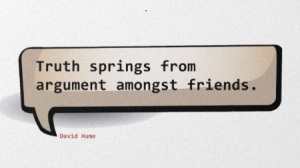Arguing among friends and segmenting audiences
Posted: 29/11/2013 Filed under: PR practice, working life Leave a comment I spoke at an evaluation best practice event at the Scottish Government a few weeks ago, which prompted two (unrelated) thoughts.
I spoke at an evaluation best practice event at the Scottish Government a few weeks ago, which prompted two (unrelated) thoughts.
The first was courtesy of Kenneth Fowler, Director of Comms at Creative Scotland, who shared David Hume’s quote at the end of his presentation on partnerships.
This resonated with me particularly because not long before that I’d met our global Chief Executive Officer, Andy Polansky, for the first (and possibly only!) time.
He’s in charge of the 2500 people in more than 80 countries that make up Weber Shandwick. It so happened he was having a holiday here and decided to make a visit to the Edinburgh office, where folk from our four Scottish offices gathered to hear his views about PR and the company’s future.
Now, I’m in no position to judge the detail of what he said – I’ve only been here for a touch over two months, after all, and with no previous agency or private sector experience. But he was very personable, credible and convincing, as you might expect, and it does says something about the man that he took a good few hours out from his holiday to meet us all.
Speaking truth to power
What struck me more about the occasion was how willing everyone was to ask him questions. And it wasn’t restricted to the more experienced or senior members of the team.
I have learnt already that, like me, most of my new colleagues aren’t shy about coming forward. But, in my experience, the rank and file staff in organisations have usually been quite reticent about questioning the top bosses.
Is this a private v public sector thing? Or is it peculiar to the public bodies I’ve been part of? Perhaps it’s to do with the fact that Andy Polansky is both structurally and geographically quite removed from us?
I know for sure that actually knowing the boss or feeling relatively close to them has been an off-putting factor in the four organisations I’ve worked in previously. There’s undoubtedly been a fear, justified or not, based on the possibility of ending up in the crosshairs of a manager who perceived an enquiry to be impertinent or otherwise disagreeable to them.
Whatever the answer is in Weber Shandwick’s case (and the precise reasons maybe don’t matter that much), it’s a good sign. A culture where people feel quite relaxed about such occasions augers well for creativity, innovation and development. Having the confidence to challenge and disagree is a precursor for avoiding one of my pet hates, and surely one of the major causes of failure in organisations, groupthink.
Segmenting audiences
The other point came up in the Q and A but unfortunately there wasn’t time to address it. The question was a follow-up to the presentation by Phil Adams of Blonde Digital about the work they do on profiling Irn Bru’s customers, and was about how public sector organisations can do similar.
What I wanted to share was that there is a good start to be found in the work of Experian and its Mosaic consumer profiling. In summary, the population is broken down into various groups and details such as their demographics, how they access the internet, their communications preferences, how ‘green’ or ‘active’ they are and so on.
 If you register for the interactive guide via the link above, you can have a look through all of the profiles for free. That has some value in itself but, of course, to get the real deal you need to pay, and for that you receive access to the proportions of profile groups in particular areas. And with that, you can then start to map or analyse all sorts of things to get a clear picture of who you’re trying to target, where they are, and how to reach them. If you have other data too, and someone who’s good with it, then all sorts of various analyses are possible.
If you register for the interactive guide via the link above, you can have a look through all of the profiles for free. That has some value in itself but, of course, to get the real deal you need to pay, and for that you receive access to the proportions of profile groups in particular areas. And with that, you can then start to map or analyse all sorts of things to get a clear picture of who you’re trying to target, where they are, and how to reach them. If you have other data too, and someone who’s good with it, then all sorts of various analyses are possible.
For example, a council could use Mosaic to:
- See which type of people aren’t keen on recycling schemes and either communicate with them better or use the contacts to understand how to improve the schemes
- Find out which people in a local authority’s patch think they’re getting a poor deal and how best to speak to them about this, or
- Learn how different groups are using online services and how to redesign those better to improve uptake.
Mosaic isn’t a panacea: it’s a start to better segmentation and understanding of audiences, rather than a blueprint to be followed unthinkingly. After all, the only way to accurately categorise a population of 5m people would be to have 5m boxes (and even then, we change our views from day to day or over time). But it’s better than working blind, and having some kind of framework makes it easier to incorporate lessons learnt from other research or experience.